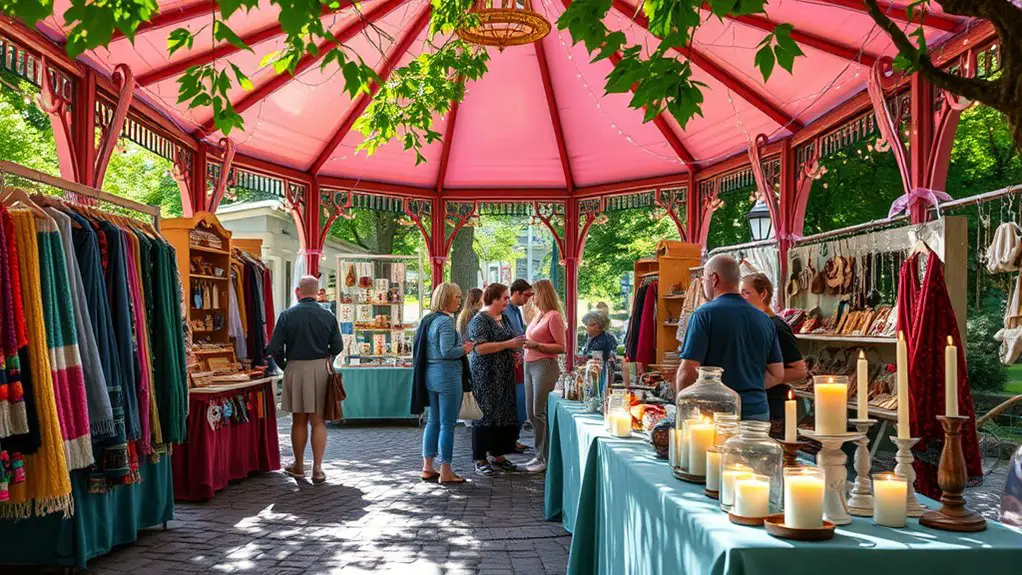Hosting a handmade goods fair under your gazebo can create a charming market atmosphere. Start by choosing a great date and time, ideally in spring or early fall. Invite local artisans and vendors to showcase diverse crafts. Design your layout for easy navigation, placing popular items at the front. Promote your event through social media and eye-catching flyers. Finally, create a welcoming vibe with decor and comfortable seating. There’s a lot more to reflect upon, so let’s explore some exciting ideas!
Choosing the Right Date and Time
When should you host your handmade goods fair to attract the most visitors? Timing is everything, so consider weather considerations and community involvement. Spring and early fall often offer pleasant temperatures, drawing people out of their homes. Weekends are ideal, especially Saturdays, when families can come together without the rush of weekday commitments.
You’ll want to avoid holidays that might split attention, like Thanksgiving or major local events. Instead, think about local festivals or farmers’ markets, as these can enhance community involvement and boost foot traffic. Collaborating with nearby businesses can also create buzz, making your fair a must-visit destination.
Consider starting your event mid-morning, allowing ample time for visitors to browse, socialize, and enjoy the atmosphere. Additionally, hosting your fair in a location near popular attractions can increase guest interest and overall attendance. By choosing the right date and time, you’re laying the groundwork for a successful handmade goods fair that celebrates creativity and freedom within your community.
Inviting Local Artisans and Vendors
To create a vibrant atmosphere at your handmade goods fair, reaching out to local artisans and vendors is essential. Start with artisan outreach—connect with artists through social media, local craft groups, and community boards. Share your vision and the unique experience they’ll be a part of. Don’t hesitate to highlight the benefits of participating, such as exposure to new customers and the chance to network.
When it comes to vendor selection, consider diversity. Aim for a mix of crafts, such as jewelry, textiles, pottery, and gourmet foods, to attract a wider audience. Guarantee each vendor aligns with the handmade spirit of your fair and maintains high quality. Personal invitations can make artisans feel valued and excited to join. Remember, each artisan contributes to the fair’s character, so choose wisely. Your thoughtful outreach and selection will create an unforgettable experience for everyone involved. Additionally, hosting the fair under a gazebo can provide adequate shade and shelter, enhancing comfort for both vendors and attendees.
Designing the Layout of Your Fair
When designing the layout of your fair, think strategically about booth arrangement to maximize visibility and engagement. Consider how pathways will guide visitors through the space, creating a natural flow that encourages exploration. A well-thought-out layout not only enhances the shopping experience but also showcases each artisan’s work effectively.
Booth Arrangement Strategies
Designing the layout of your fair can greatly impact both vendor experience and customer engagement. Start by considering booth aesthetics; cohesive designs attract attention and create a pleasant atmosphere. Encourage vendor collaboration by placing complementary booths near each other, allowing for creative synergies. For instance, a jewelry maker next to a fabric artist can spark unique cross-promotions.
Ensure there’s enough space for vendors to showcase their products effectively without feeling cramped. Use varied heights and displays to draw the eye, and position popular items at the front to entice customers. Remember, a well-thought-out arrangement not only enhances the visual appeal but also fosters a sense of community among vendors, making the experience enjoyable for everyone involved.
Pathways and Flow
Creating clear pathways is essential for guiding visitors through your handmade goods fair. Thoughtful pathway design not only enhances visitor navigation but also encourages exploration. Start by mapping out main aisles that connect booths, allowing for easy movement and interaction. Consider using decorative elements like plants or signage to delineate these paths, creating an inviting atmosphere.
Ensure pathways are wide enough for groups to pass comfortably, and avoid clutter that might hinder flow. Incorporate seating areas along the way where guests can relax and engage with your artisans’ stories. By prioritizing a natural flow, you’ll foster a sense of freedom, inviting attendees to wander, discover, and immerse themselves in the vibrant world of handmade creations.
Promoting Your Event
Successfully promoting your handmade goods fair can make all the difference in attracting a diverse crowd and guaranteeing a vibrant atmosphere. To get the word out effectively, consider these strategies:
- Leverage Social Media: Use platforms like Instagram and Facebook to showcase your vendors and products. Create event pages to encourage sharing.
- Craft a Press Release: Write a catchy press release to distribute to local media. Highlight unique aspects and include essential details like date, time, and location.
- Engage with Local Influencers: Partner with local bloggers or influencers who align with your fair’s theme. Their reach can draw in a wider audience.
- Utilize Flyers and Posters: Design eye-catching materials to display in local shops and community centers. Make sure they reflect the spirit of your event. Additionally, consider hosting your fair in a gazebo to provide shade and shelter for both vendors and attendees, enhancing the overall experience.
Creating a Welcoming Atmosphere
While it’s easy to focus solely on the products being sold, the atmosphere at your handmade goods fair is equally important in making attendees feel welcome and engaged. Start by setting the mood with atmospheric lighting. Twinkling fairy lights or soft lanterns can create a cozy, inviting space under your gazebo. Additionally, using energy-efficient lighting can help you save on electricity costs while providing a warm ambiance.
Next, consider comfortable seating arrangements. You want your guests to linger and enjoy the experience. Here’s a quick look at creating that inviting vibe:
| Element | Purpose |
|---|---|
| Atmospheric Lighting | Enhances mood and creates warmth |
| Comfortable Seating | Encourages relaxation and engagement |
| Welcoming Decor | Adds personality and charm to the space |
Engaging Activities for Visitors
To truly captivate your visitors at the handmade goods fair, incorporating engaging activities can elevate their experience and foster a sense of community. Here are some ideas you can implement:
- Craft Workshops: Invite local artisans to lead hands-on workshops, allowing attendees to create their own unique pieces.
- Interactive Demonstrations: Set up live demonstrations where artisans can showcase their skills, sparking curiosity and conversation among visitors.
- Photo Booth: Create a themed photo booth with props related to handmade crafts, encouraging visitors to capture memories and share them on social media.
- Creative Contests: Organize friendly competitions, such as a “Best Handmade Creation” contest, where visitors can showcase their talents and win prizes.
In addition to these activities, consider hosting your fair in a durable semi-permanent gazebo to provide shelter and enhance the overall atmosphere. These activities not only provide entertainment but also foster connections among attendees, making your fair an unforgettable experience. So, embrace the spirit of creativity and community!
Managing the Day of the Event
On the day of your handmade goods fair, having a clear setup timeline is essential for a smooth start. You’ll need effective vendor coordination strategies to guarantee everyone knows their roles and responsibilities. Additionally, managing event flow will keep the atmosphere lively and enjoyable for all attendees. To enhance the experience, consider installing mosquito netting to keep pests away during the event.
Set Up Timeline
As you gear up for the handmade goods fair, establishing a clear set-up timeline is essential for guaranteeing everything runs smoothly on the day of the event. While it’s important to stick to your schedule, allow for some timeline flexibility to adapt to any surprises.
Here’s a simple set-up essentials checklist:
- Arrive Early: Aim to get there at least two hours before the event starts.
- Set Up Tables and Displays: Confirm your booth is visually appealing and functional.
- Organize Inventory: Arrange products neatly for easy browsing.
- Final Touches: Add signage, decorations, and confirm everything is in place 30 minutes before opening.
With this timeline, you’ll create a welcoming atmosphere, allowing creativity and freedom to flourish!
Vendor Coordination Strategies
While managing a handmade goods fair, effective vendor coordination is essential for ensuring a seamless experience for both sellers and attendees. Start by clearly outlining vendor requirements ahead of time, including setup times, space dimensions, and any necessary permits. On the day of the event, utilize communication tools like group messaging apps or walkie-talkies to keep in touch with your vendors. This allows you to address any issues swiftly, from late arrivals to last-minute needs. Assign a point person for each vendor to facilitate streamlined communication and provide support throughout the day. By staying organized and fostering open lines of communication, you’ll create a vibrant atmosphere where vendors feel empowered to connect with customers and showcase their handmade creations.
Event Flow Management
After ensuring that vendor coordination is on point, the next step is to manage the event flow effectively. You’ll want to focus on smooth event logistics and crowd management to create an enjoyable experience for everyone. Here are four key elements to take into account:
- Entry and Exit Points: Set clear paths for attendees to enter and exit without confusion.
- Booth Layout: Arrange vendor spaces to encourage exploration and minimize bottlenecks.
- Signage: Use clear, attractive signs to guide visitors and highlight key areas, like restrooms or food stalls.
- Staff Presence: Position volunteers strategically to assist with questions and keep things flowing.
Frequently Asked Questions
What Permits Do I Need to Host the Fair?
Maneuvering permits is like assembling a puzzle; you’ll need various permit types based on your location. Check local event regulations to guarantee compliance, covering vendor licenses, health permits, and possibly noise ordinances for a smooth experience.
How Can I Ensure Vendor Diversity at the Fair?
To guarantee vendor diversity, focus on vendor outreach and community engagement. Connect with local artists, minority-owned businesses, and diverse groups. Promote inclusivity through social media and partnerships, creating a vibrant marketplace that reflects your community’s richness.
What Should I Do in Case of Bad Weather?
Ah, the weather’s unpredictable charm! For rain contingency, have a backup venue ready and guarantee vendor communication is clear. This way, everyone’s prepared to adapt, embracing spontaneity while staying dry and enjoying the fair.
How Can I Handle Vendor Payments and Transactions?
To handle vendor payments, consider using mobile payment options for convenience. Guarantee transaction security by advising vendors to use encrypted apps and double-check payment confirmations, keeping your event safe while allowing everyone to enjoy their freedom.
What Safety Measures Should I Consider for My Event?
For your event, implement safety protocols like first aid stations and accessible emergency contacts. Make certain vendors know evacuation routes and have fire extinguishers on hand. It’ll keep everyone secure and allow for a worry-free experience.

